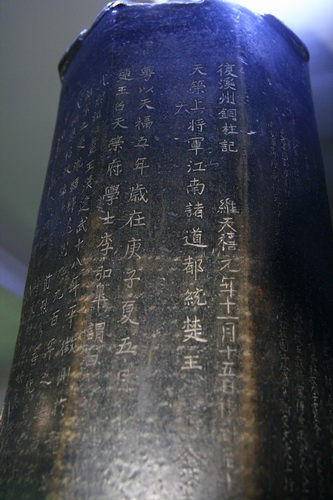Xizhou Copper Pillar
Xizhou Copper Pillar is located inside the Hall of Folk Customs and Scenic Spots of Furong Town. It was originally built near the bank of Youshui River under Yejituo, Yongshui County. As Fengtan Reservoir was to be built, Xizhou Copper Pillar was relocated to its present site in 1971. It is a place of interest with a history of about 1,000 years in Xiangxi Prefecture (photos 1-2, 1-3). In 1961, the pillar was listed into the first batch of Key Cultural Heritage Sites under the State Protection by the State Council.
After the Xizhou War, Ma Xifan (899 – 947, King of Chu) and Peng Shichou (? – 956, chief of the local tribe) set up a copper pillar as the boundary tablet to divide their own territories. The pillar measures 4m high, with an eight-sided upper part and a round-shaped lower part. It has a diameter of 39cm. The hollowed-out pillar weighs 2.5t. The body of the pillar is inscribed with the text entitled Record on the History of Xizhou Copper Pillar. The text contains more than 2,300 Chinese characters in 41 lines (photo 1-4). The inscription also includes a piece of oath and title names which are written in elegant regular script.
Xizhou Copper Pillar is the historical evidence of how the regimes in ancient China settled a dispute between people of different ethnic groups. It is a milestone in the gradual formation of a Tusi system (a system of appointing ethnic minority hereditary chieftain) in the areas adjacent to today’s Chongqing, Hunan, Hubei and Guizhou. The setting up of Xizhou Copper Pillar marked the establishment of Tusi system which was the earliest system of autonomous rule practiced in the ethnic minority areas in ancient China.

Photo 1-2 Xizhou Copper Pillar

Photo 1-3 Record on the History of Xizhou Copper Pillar
QR Code



